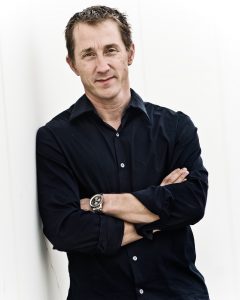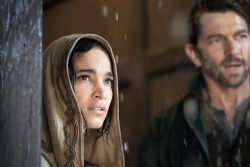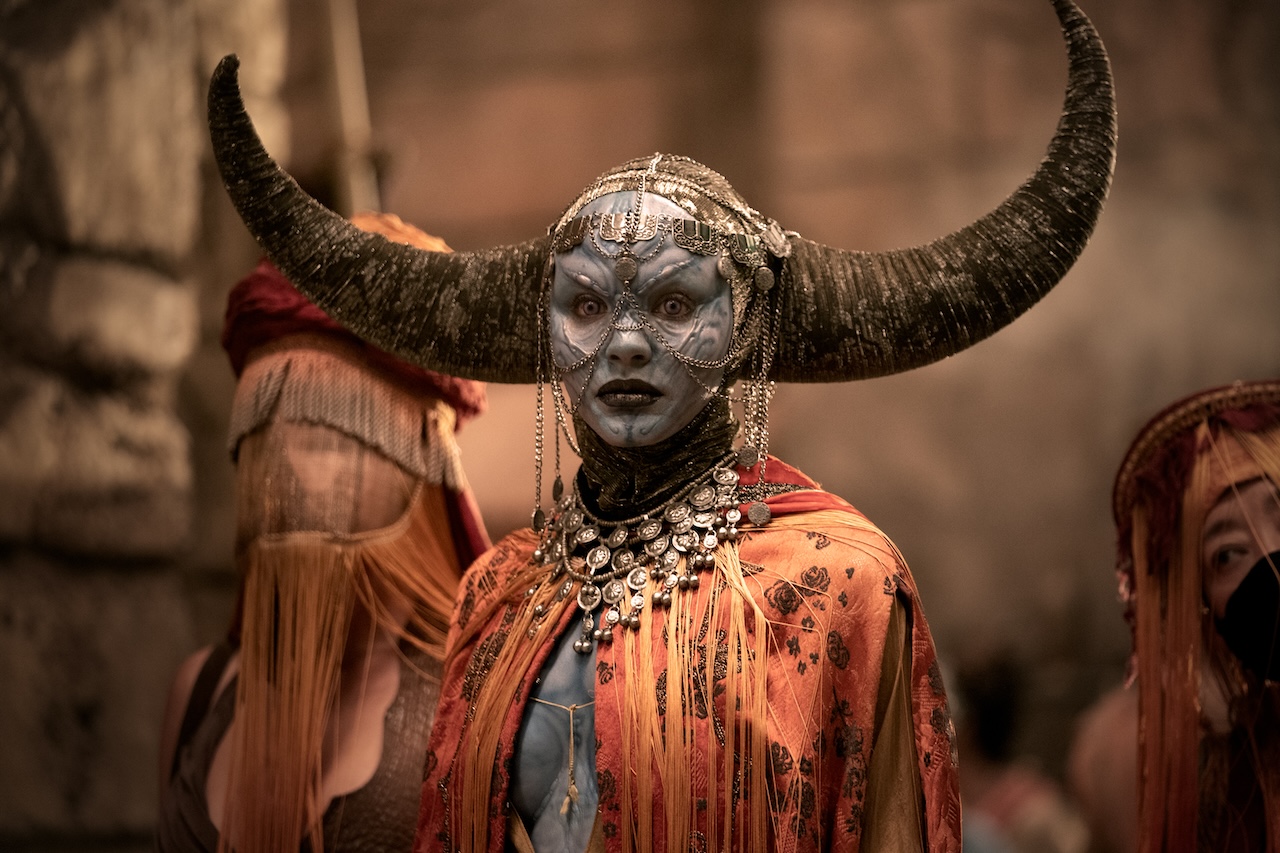Kurt Johnstad and Zack Snyder have enjoyed a fruitful creative relationship collaborating on many popular films including 300. Rebel Moon is a sprawling space odyssey that spills over into two parts. Part One: A Child Of Fire is the setup of the story and stars Sofia Boutella, Charlie Hunnam and Ed Skrein. Part 2: The Scargiver will feature more of the Mother World and Kora’s (played by Boutella) backstory.
“Zack Snyder and I have a long friendship of over thirty years and we’ve always been interested in storytelling. We would always end up sitting around a fire and tell stories about our childhoods or stories that we loved,” says co-writer Kurt Johnstad.
Snyder first approached Johnstad in 1997 with a loose concept for Rebel Moon. “We started working on character, scene structure, and action sequences maybe five years later. We started roughing things out,” he continues.
Kurt also comments on the unusual way the film (and most films) he’s co-written with Zack. Snyder writes the first and last five to ten pages of each script and Johnstad fills in the rest. “It creates a creative bookend where Zack sets the tone immediately. We see and hear the sonic and visual scope of what he’s trying to accomplish,” continues Johnstad. “And then we start leapfrogging scenes.”
They wrote a very detailed outline of around forty pages for Rebel Moon before assigning pages and scenes to each other. “I did a lot of the gathering of the team and Zack was doing more of the Noble story,” elaborates Kurt. Shay Hatten (John Wick: Chapter 4, Night Shift) came into the writing fold later.
Developing The Project
The twenty-five year gestation period for Rebel Moon involved deciding the in and out points for key scenes and where they dovetail.
“Zack would hand me a scene, or some pages, and I’ll laugh because he just raised the bar again. It’s a lovely creative competition where you’re constantly pushing each other and forcing each other not to be safe. We really get to explore the deep waters and the wells of our creativity.”

Kurt Johnstad
The robustness of this development process creates trust and faith between them, so when Shay Hatten joined the writing team, Zack knew Rebel Moon was in good hands. “It’s an alchemy where you’re turning lead into gold. Zack has always been very generous with me and lets us try different things. And I respond the same way,” notes Johnstad.
There are about half a dozen creatives in Snyder’s inner sanctum who helped him shepherd Rebel Moon over the years. At one point, it was pitched as a television series, but ultimately landed as a two part inter-planetary opera.
The current draft didn’t go into full force until around 2020. “Zack and I started to draft initially and we got probably about ninety or a hundred pages written. Zack got pulled into re-editing his Justice League cut and he just didn’t have the bandwidth to continue. We weren’t turning pages in as fast as we wanted to. Shay Hatten had just completed Army Of The Dead and Zack and we both trusted him so we invited him to write a pass.”
“Shay hit the ground running. He has such a strong work ethic and is so good at his craft that he was able to integrate very quickly with the ‘Zack and Kurt creative process.'”
Kurt Johnstad is well aware of Zack Snyder’s expansive creative canvas from his commercial and music video days. “I’ve never been on a film set where in the scope and scale, the magnitude of execution, creative vision that was happening was so big. We were trying to just write one movie with A Child Of Fire.”
The early drafts were over two hundred pages long in 2008. Snyder and Johnstad grappled the ambitious scope of it. “Then we started culling; scrolling through the script and thinking what we can lose. We got down to a draft that was around 138 pages. We thought that might be acceptable.”
“Then we looked at it and thought all the heart of the movie and all the cool stuff is gone. The characters and the world are suffering. Then, all of us collectively, were looking at the 200 plus page draft to see what we could restore. At around page 92, we thought we could write an ending and we could shape Rebel Moon into two movies. I think it ended up being an 189 page shooting draft for both movies.”
There were few rewrites after they submitted the draft to Neftlix. They did a cleanup pass prior to submission and two polishes for Netflix to address minor issues.
Zack Snyder prepared two cuts of Rebel Moon – the PG-13 and an R-rated cut.
Crafting Rebel Moon For Longevity
“Kora represents the grand scheme of humanity. We’re both students of Joseph Campbell in terms of the hero’s journey.” Growing up, Zack Snyder’s favorite films were George Lucas’ Star Wars and Kurosawa’s Seven Samurai. These influences are apparent in Rebel Moon.
“We stand on the shoulders of the giant filmmakers that come before us. There’s absolutely no way that you can’t see the ‘tipping of hats’ even to where we have characters in Rebel Moon that are named after greats like John Milius (there is a character Milius played by E. Duffy) because he was such a rebellious screenwriter. There are all of those kinds of Easter eggs scattered throughout it.”
Snyder and Johnstad created a very detailed bible comprising hundreds of pages of the characters and the world before commencing writing the script. “If we think of this first movie as the hub of the universe, as the starting point, then bifurcating from that hub, we’re going to have storylines continuing for as long as we want,” comments Johnstad, suggesting there may be further instalments of the Rebel Moon saga.
“We have a very deep, rich mythology and lore of the Mother World, of the rebellion, the blood axes, histories of their planet, their parents and their grandparents. We really created a world where we could move forwards and backwards through time. We needed to be able to know if this is Princess Issa (Stella Grace Fitzgerald), but there were many Princess Issas before her through a thousand kings in the Mother World’s history.”
Kurt admits the in challenging in tracking so many characters and story elements. They were aided by whiteboards filled with arrows, diagrams, and bullet points… and endless patience.
Universal Themes
An inter-planetary epic saga like Rebel Moon requires epic-sized themes to carry it. “Redemption, duty, the idea of a family structure that can be broken, and how that can be tested, are all explored,” explains Johnstad.
“There is also this interior work that we tried to layer into each character. They had gone through trauma, there was sacrifice, there was humility, and now there was a thin veneer of how they were containing themselves and moving through these worlds, even if they were on the run.”
Rebel Moon also examines the alliance the rebels formed when they trusted a group of outsiders. When they finally came together, they were more powerful than themselves. They were able to heal themselves.
These large scale stories of protecting one’s homelands and unabashed greed have been told for many years. “Of course we were inspired by Kira Salek, who, in-turn, inspired the Western. We could take the tropes of the powerful and the few that have so little and the powerful that have so much. From the Greeks through to Shakespeare have been telling this story for centuries. We’re just telling our version of the story and we’re setting it somewhere out there in the darkest areas of space.”
“I think that’s the beauty and magic of art. If you look at a painting, if it holds you in an aesthetic arrest, and you’re in the moment, you’re going to think, ‘Wow, that painting moved me. Something inside of me was touched by that. We’re trying to create a world and let people experience it.'”
Handling Exposition
Building large, intricate worlds requires delivering huge amounts of backstory, rules, and geographical information. This needs to be done with minimal interruption to the forward momentum of the narrative.
“One of the devices that Zack and I have found effective is for a storyteller to cut in and out to deliver essential information without them becoming a major character that requires their own story.” Rebel Moon uses the character of Jimmy (Sir Anthony Hopkins) to fulfil that role as the voice of the robot.
“We’re able to tell the story, the mystery, and the mythology of Princess Issa, the Mother World. We can make these human connections to the audience through hundreds of years through a robot telling us some of this information.”

Kora (Sofia Boutella) & Gunnar (Michiel Huisman). Photo by Chris Strother/ Netflix
“There are a few of those scenes where Kora does it too. She does it in a very cinematic, almost Western John Ford trope, where you sit around the campfire with Gunner (Michiel Huisman) and she says, ‘Do you want to know why? I’ll tell you why. She just gives a tiny bit of information. She does that twice in movie one where she layers as she’s speaking to another character. It works very well to recalibrate the audience into a past tense or into a flashback.”
Writing Voice
“I’m certainly drawn towards strong female characters, usually at the front of the film. Atomic Blonde would be another one of my movies where you get to play with some of the tropes of that spy genre and you get to make it fun with a strong female lead. You get to create more of a pop culture. You get to make it a little more entertaining, but still visceral and cool.”
Kurt doesn’t write stock male characters that can be played by female actresses. He believes a woman can carry a lead role as well as a man. Much of this ethos was inspired by James Cameron with commanding performances by Sigourney Weaver as Ripley in Alien or Linda Hamilton as Sarah Connor in Terminator.
“I love that part of my work because there needs to be more strong women that can advocate and just own that cinematic space.”
Kurt confessed that he’s not a big fan of over-writing so he doesn’t give the actors too much dialogue. “I really believe in the silences between the words and between all the lines.”
He references the first few minutes of Rebel Moon where Kora pulls the rock out of the stone. “She’s standing there looking out and she’s in a moment in her own interior world thinking. She just smelt the soil of Veldt. It was a surprising moment.”
[More: I was never conscious of my screenplays having any acts. – John Milius]
[More: Shay Hatten and Michael Finch Discuss “John Wick: Chapter 4″]
